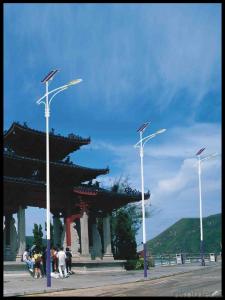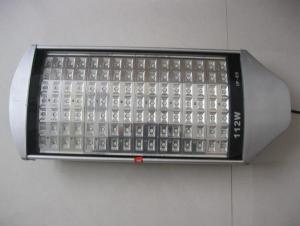Solar Light Kit - High Efficiency Solar Street Lights R200
- Loading Port:
- Shanghai
- Payment Terms:
- TT or LC
- Min Order Qty:
- 10 pc
- Supply Capability:
- 10000 pc/month
OKorder Service Pledge
OKorder Financial Service
You Might Also Like
1, Product desciption
Inverter circuits designed to produce a variable output voltage range are often used within motor speed controllers.
The DC power for the inverter section can be derived from a normal AC wall outlet or some other source. Control and feedback circuitry is used to adjust the final output of the inverter section which will ultimately determine the speed of the motor operating under its mechanical load.
Motor speed control needs are numerous and include things like: industrial motor driven equipment, electric vehicles, rail transport systems, and power tools. (See related: variable-frequency drive ) Switching states are developed for positive, negative and zero voltages as per the patterns given in the switching Table.
The generated gate pulses are given to each switch in accordance with the developed pattern and thus the output is obtained.
And magnifying glass is then used to warm up the pipe.
Using more than one magnifying glass will increase the temperature more rapidly.
2, Features of the product
Inverters convert low frequency main AC power to higher frequency for use in induction heating.
To do this, AC power is first rectified to provide DC power. The inverter then changes the DC power to high frequency AC power. Due to the reduction in the number of DC Sources employed, the structure becomes more reliable and the output voltage has higher resolution due to an increase in the number of steps so that the reference sinusoidal voltage can be better achieved.
This configuration has recently become very popular in AC power supply and adjustable speed drive applications. This new inverter can avoid extra clamping diodes or voltage balancing capacitors. There are three kinds of level shifted modulation techniques, namely: 1,High and stable conversion efficienly based on over 4 years professional experience
2 ,High reliability with guaranteed +/-10% output power tolerance
3,Proven materials,tempered front glass,and a sturdy anodized aluminum frame allow modules to operate reliably in multiple mountily configurations
4,Combination of high efficicncy and attractive appearance
The first thing to figure out is the length of road in need of street lights.
This can be a small entrance road only a couple hundred of feet long to miles of streets through an area. Does the area currently have any type of lighting available.
What is the reason for needing street lights in this area
Is the electrical grid already nearby or would you need to call in the power company to bring in electrical lines.
If the electric needs to be brought to the area, how much is this going to cost? Depending on how far the grid electric is from the location of the needed lighting, this can be quite expensive.
How much lighting is needed on the street? Do the lights need to be dark sky compliant.
Do the street lights need to run from dusk to dawn or for only a specified number of hours at night.
Are the street lights able to dim in the middle of the night and still provide enough lighting.
These questions need to be answered before you can decide on how many lights you will need to complete the project.
3, Detailed Specification
| ||||||||||||||||||||||||||||||||||||||||||||||||
4, Product Image

- Q: Are there solar lights specifically designed for indoor use?
- Yes, there are solar lights specifically designed for indoor use. These lights are usually compact, portable, and can be used to provide illumination in areas without access to electricity. They are often used in spaces such as sheds, garages, closets, and even in emergency situations.
- Q: Are solar lights suitable for flagpole lighting?
- Yes, solar lights are suitable for flagpole lighting. They are a cost-effective and environmentally friendly option, providing sufficient illumination for flag display at night. Additionally, they eliminate the need for electrical wiring and are easy to install and maintain.
- Q: Are solar lights suitable for historical buildings?
- Yes, solar lights are suitable for historical buildings. They provide a sustainable and cost-effective lighting solution that does not require any external electrical connections or extensive wiring. Solar lights can be easily installed and do not disrupt the architectural integrity of historical buildings. Additionally, they offer flexibility in placement and can be adjusted to highlight specific architectural features or pathways, enhancing the overall aesthetics of the building while preserving its historical value.
- Q: How do solar lights provide illumination during cloudy days?
- Solar lights are equipped with a battery that stores the energy collected from the sun during sunny days. This stored energy is used to power the lights during cloudy days when there is limited sunlight available.
- Q: Are solar lights suitable for mining operations?
- Solar lights can be a suitable lighting solution for mining operations, depending on the specific needs and conditions of the mine. Here are a few factors to consider: 1. Remote locations: Many mining operations are located in remote areas where access to electricity is limited or non-existent. In such cases, solar lights can provide a cost-effective and sustainable lighting solution without the need for expensive infrastructure development. 2. Reliability and durability: Solar lights are designed to withstand harsh environmental conditions, making them suitable for mining operations that often face extreme weather, vibrations, and dust. They are built with high-quality materials to ensure long-term reliability and minimal maintenance requirements. 3. Safety and security: Proper lighting is crucial for ensuring the safety and security of mining operations. Solar lights can illuminate working areas, walkways, and access points, reducing the risk of accidents and enhancing overall site security. 4. Energy efficiency: Mining operations consume significant amounts of energy, and using solar lights can help reduce the reliance on fossil fuels and lower operational costs. Additionally, solar lights have built-in energy-saving features such as motion sensors, allowing for further optimization of energy usage. 5. Environmental impact: Mining operations often have a significant environmental footprint. By using solar lights, mining companies can reduce their carbon emissions and contribute to a cleaner and more sustainable energy future. However, it is important to assess the specific lighting needs and requirements of the mining operation before implementing solar lights. Factors such as the intensity and coverage of light required, the availability of sunlight in the area, and the overall energy demand of the mine should be taken into account. Consulting with experts in solar lighting solutions can help determine the suitability and feasibility of solar lights for a particular mining operation.
- Q: Can solar lights be used as a deterrent against intruders?
- Yes, solar lights can be used as a deterrent against intruders. The bright light emitted by solar lights can effectively discourage potential intruders as it increases the visibility of the surroundings. Additionally, solar lights often have motion sensors, which can further startle and deter intruders. The presence of well-lit areas can give the impression that someone is home and actively monitoring the property, making it less attractive for potential burglars or trespassers.
- Q: Can solar lights be used in areas with high levels of dust storms or sandstorms?
- Yes, solar lights can be used in areas with high levels of dust storms or sandstorms. However, it is important to choose solar lights that are specifically designed to withstand such harsh conditions. These lights should have features like sealed components, durable materials, and protective covers to prevent sand or dust from entering the light and causing damage. Additionally, regular maintenance and cleaning may be required to ensure optimal performance in dusty environments. Overall, with the right selection and proper care, solar lights can effectively function in areas prone to dust storms or sandstorms.
- Q: Can solar lights be used for camping or RV lighting?
- Yes, solar lights can definitely be used for camping or RV lighting. In fact, they are a popular choice among campers and RV enthusiasts due to their convenience, portability, and environmentally-friendly nature. Solar lights are designed to harness energy from the sun and convert it into electricity, which is stored in rechargeable batteries. This means that you don't need access to electricity or worry about running out of power. Solar lights come in various forms such as lanterns, string lights, spotlights, and even portable solar panels that can charge multiple devices simultaneously. They are lightweight, easy to set up, and require minimal maintenance. Many solar lights also have adjustable settings, allowing you to control the brightness or choose different lighting modes to suit your needs. Camping and RV lighting often rely on battery-powered or fuel-based options, which can be costly and have limited run times. Solar lights, on the other hand, offer a sustainable and cost-effective alternative. They can be placed outside during the day to charge and then brought inside your tent or RV at night for illumination. Furthermore, solar lights are typically designed to withstand outdoor conditions, making them durable and reliable for camping or RV trips. Overall, solar lights are a fantastic choice for camping or RV lighting. They provide a renewable and energy-efficient solution, allowing you to enjoy the great outdoors while minimizing your carbon footprint. Whether you need ambient lighting, task lighting, or even security lighting, solar lights can fulfill all these purposes and make your camping or RV experience more enjoyable.
- Q: Do solar lights have a built-in dusk to dawn sensor?
- Indeed, a multitude of solar lights are equipped with a built-in sensor that detects the transition from dusk to dawn. Through this sensor, the light is able to autonomously activate at nightfall and deactivate at daybreak, eliminating the necessity for manual intervention. By gauging the surrounding light levels, the dusk to dawn sensor prompts the light to ignite in darkness and extinguish upon the arrival of daylight. This characteristic not only guarantees convenience but also contributes to energy conservation by solely illuminating the light when it is truly necessary. Nonetheless, it is crucial to bear in mind that not all solar lights possess this attribute, hence it is always recommended to verify the product specifications prior to purchase.
- Q: Can solar lights be used for remote control operation?
- Yes, solar lights can be used for remote control operation. Many solar lights come with a remote control option that allows users to turn the lights on or off, adjust brightness levels, switch between different lighting modes, and set timers. The remote control operates wirelessly, allowing users to control the lights from a distance. This feature is particularly useful for outdoor spaces, such as gardens or pathways, where it may be inconvenient to manually access the lights. Solar lights with remote control operation provide convenience, flexibility, and energy efficiency, making them a great option for various applications.
Send your message to us
Solar Light Kit - High Efficiency Solar Street Lights R200
- Loading Port:
- Shanghai
- Payment Terms:
- TT or LC
- Min Order Qty:
- 10 pc
- Supply Capability:
- 10000 pc/month
OKorder Service Pledge
OKorder Financial Service
Similar products
Hot products
Hot Searches
Related keywords




























